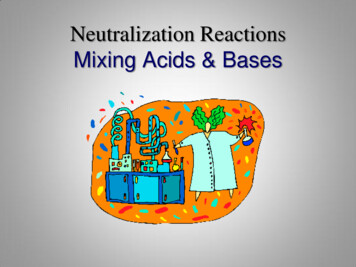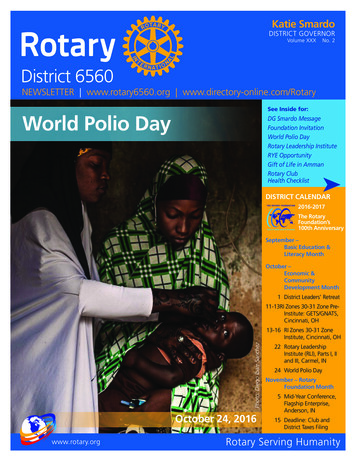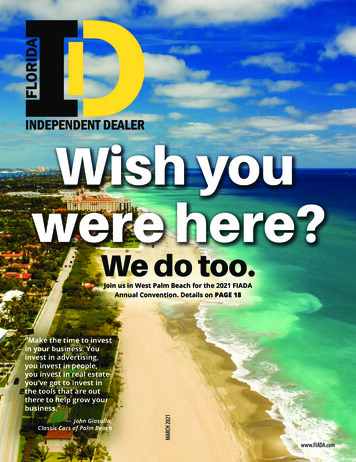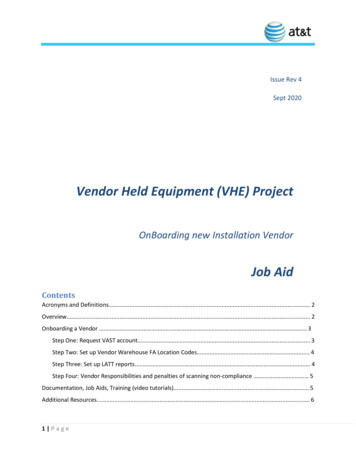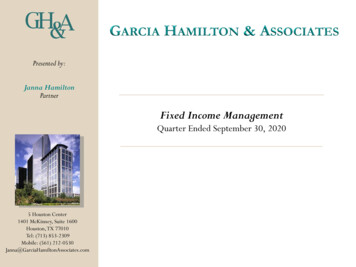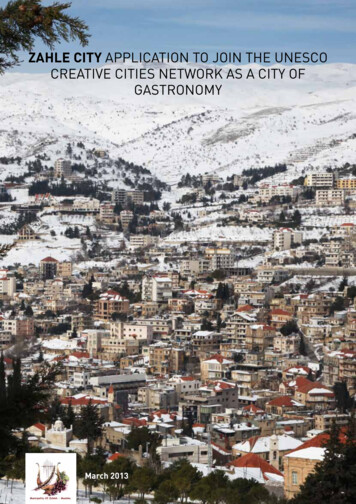
Transcription
ZAHLE CITY APPLICATION TO JOIN THE UNESCOCREATIVE CITIES NETWORK AS A CITY OFGASTRONOMYMarch 20131
TABLE OF CONTENT1.2.3.4.5.6.7.8.9.10.11.12.13.14.MANAGEMENT TEAMVISIONMISSIONGEOGRAPHYCOMMUNITYSTORY OF THE CITYRESOURCESCULTURE & TRADITION– poetry, literature, photography, painting ECONOMYGASTRONOMYFARMERSTHE GRAPE ROUTE: OF WINE AND ARAKFESTIVALS & CULTURAL P59SOURCESAPPENDIXP60P602
From the Municipality of ZahlePresident of the Municipality: Joseph Maalouf(president@zahle.gov.lb)Elise Estephan Tamer, lawyer and teacher at LawUniversity. Chairwoman of Zahle Municipality.(tamerelise@hotmail.com)Youssef Skaf, municipality counsellorYoussef Kerouni, lawyer and co-owner of a pressgroup.Samir Mallo, dentist, member of the Municipality.Michel Ballech, lawyer & counsellor.Elias Chamoun, counsellor.1. MANAGEMENT TEAMThe idea of Zahle joining the ‘Creative CitiesNetwork’ came up naturally formulated byJoseph Kreidi, Programme Officer for Culture atUNESCO-Beirut Office. Mr. Kreidi appointedChérine Yazbeck, a local food culture specialist tofulfil the task. Zahle has been committed for over acentury to the spread and recognition of traditionalLebanese food.As a long-time gastronomy leader in the region,Zahle intends to develop the cultural food heritagewith ambitious projects. With its assets, Zahle aimsto attract even more visitors into the region bysupporting the creative local food community. Administration & culture of ZahleSaid Gédeon, executive at Bekaa Chambre ofCommerce and Agriculture. (said@cciaz.org.lb)Khalil Geha, CEO of Geha company, and specialistof the history of Zahle. (khalilggeha@yahoo.com)Feyrouz Chamoun, founder of Zahle HistoricMuseum.As the person responsible for the project, I havecontacted the main actors of the food industryworking hand in hand with the Municipalityof Zahle and at its head, Mr. Joseph Maalouf. Imet a substantial number of farmers, small-scaleproducers, foodies, restaurant owners, pastry shopowners, bakeries owners, industrials, politicians,entrepreneurs, cultural main figures and tourismexperts who expressed a great interest in joiningthe ‘Creative Cities Network’ that would put Zahleon the map and encourage the city to acquire aregional and international status of gastronomiccity. The two main zahliots that helped me fulfil thisproject are Khalil Geha, a prominent figure of Zahleand Irène Alouf, owner of an eco-friendly organicboutique hotel in Zahle. This achievement wouldalso connect Zahle to other cities that are alreadypart of the global network. Food experts & hospitalityIrène Alouf, owner of an organic guesthouse inZahle. (irene@beitelkroum.com)Johayna Dawalibe, nutritionist in ZahleAziz Wardy, owner of winery Wardy, Zahle.(aziz@domainewardy.com)Jean-Paul Khoury, owner of winery ChâteauKhoury, Zahle.Sébastien Khoury, wine expert and owner ofDomaine de Baal, Zahle.(sebastien@domainedebaal.com)Michel Mhanna, food specialist, owner of oldestBerdawni restaurant, Mhanna, Zahle.Jean Arabi, mezze expert, owner of Casino Arabi,Berdawni, Zahle.Pascal Nmeir, owner of Casino Nmeir, Berdawni,Zahle.Elie Ghattas, chef and owner of restaurants inZahle.Clément Tannouri, Zahle photographer, writer.(info@clementtannouri.com)Rosine Zahlaoui, founder of Artisan guild, Zahle.Kamil Skaff, owner of Skaff Farm.Barbara Abdeni Massaad, food writer, author of‘Mouneh’.Nicolas abou Fayssal, owner of Gardenia Graind’Or, food company, Zahle.Walid Mouzannar, member of L’AcadémieInternationale de la Gastronomie, Lebanon.Kamal Mouzawak, founder of the Farmer market,Souk el Tayeb.The Team that will work on the follow-up of thisproject is composed of committed locals. Point PersonChérine Yazbeck: Project Coordinatorchessyaz@gmail.comLebanese food expert, food writer, journalist andphotographer.Author of ‘The rural taste of Lebanon – a foodheritage trail’, ‘Le Liban Gourmand’ (a foodieguide), ‘Le Liban Autrement’ (ecotourism guide),‘A Complete Insiders Guide to Lebanon’ and the‘Shouf Cedars Reserve’ guidebook.3
2. VISIONwith many cultures as it has always proven to dothroughout the centuries.It is even more significant now that the Middle Eastis going through turmoil and major changes in thescope of the Arab Spring. Zahle finds itself in themiddle of this (re)evolutionary process.The aim of this application is to enable the cityto push forward new diversification projects byattracting new contributors in many fields andmainly in the food sector.Zahle wishes to encourage and unite creative smallscale farmers, artisans and producers in order toacquire the local economy based on good and fairfood alongside a sustainable and reliable farming.Residents of Zahle and to a certain extent the Bekaaresidents have always been keen on safeguardingtheir traditions through handicrafts and thetransmission of food heritage. They feel a certainpride in the preservation of this expertise.In the event of integrating Zahle to ‘CreativeCities Network’, the city would boost gastronomicprograms focused on the tradition linked tomodern techniques. The incentive would draw thepath of a renewed yet active region whereby locallyproduced food would be highly represented andpromoted giving a serious push to local economies.In the scheme of designing the project applicationto integrate Zahle into ‘Creative Cities Network’, wewould like to establish the legacy of Zahle as theheritage city for regional food. Unesco confidenceand focus on the city would certainly initiate ageneral interest into the story and culture of thecity that lies at the crossroad of many routes.Gastronomy and Zahle are strongly connectedsince decades. Located in the midst of theagricultural region of the Middle East, Zahle enjoysan ideal place whereby regional cultures mingle andinteract.‘Creative Cities Network’ would empower thestrengths of the local communities to join andimprove fair trade, exchange, know-how anddiversity.Harvests, the land, the attachment to localproduces, the respect of Mother Nature, theconnexion to the region are elements that havebeen driving Zahle for centuries.Natural resources are essential assets to the city andthey all end up designing a unique cultural profile.Zahle has a strong will to come together with citiesacross the world to share its story and connect4
3. MISSIONwould draw a better future to the food industryalongside a healthier and environment drivenagricultural economy.Zahle is a city with a strong rural identity. Itis located at the heart of the Bekaa Plateau ina sparsely populated region. Zahle boasts along-lasting culinary tradition with a stunninggastronomic culture based on locally producedsustainable food.The objective of being part of ‘Creative CitiesNetwork Unesco’ is to place Zahle on the globalmap and to raise interest in preserving its regionalinput.Zahle wishes to apply to ‘Creative Cities Network’in order to boost the local economy driven mainlyby its gastronomic assets.The city is already a main actor in the region whenit comes to food heritage culture and would like togenerate a global interest on the regional wealth,food.The city would enhance food related projectsas well as investments in the sustainable foodproduction. Indeed, the city intends to developinterests in fair and organic food processes that5
4. GEOGRAPHYmetres in a narrow geographical area.The Berdawni was at a time the town’s source ofdrinking water and its most prized natural emblem.The river winds through the valley, fringed withmasses of foliage, in which tall and stately poplarspredominate the rich vineyards clothing the wholeslopes of the mountains and wild glens that furrowtheir sides.A blessed geographical locationZahle is 50 kilometers far from Beirut, in the heartof the country at an equal distance between thenorth, the south, the east and the west. Hence, itenjoys a strategic location in the most renownedfertile land.Zahle is built upon a series of foothills of themountain, at the Western edge of the Bekaa plateau,with Mount Sannine 2,628 metres towering aboveit. It is on the brow of a mountain of which thereare sublime views of the extensive vale bounded oneach side by lofty mountains.Zahle is built in an inlet of the mountain, on asteep ascent, surrounded with vineyards. The riverBerdawni issues from a narrow valley into the plainand waters the gardens of Zahle.Zahle has a delightful prospect of the fertile plain –once referred to as “the grain warehouse of Rome”and the surrounding outlook enhances it sereneatmosphere.The hills form a narrow valley, an extension ofa ravine to the northwest (“Wadi el Arayesh” orValley of Vines).Due to its unique topography, Zahle outskirtsspread vertically on steep hill slopes, and the townfeatures an elevation difference of more than 200ClimateZahle enjoys a Mediterranean climate characterizedby hot and dry summers and cold and chillywinters, where most of the precipitation isconcentrated.However, due to its high altitude and inlandlocation, in the rain shadow of the Lebanonmountains, its climate features some continentalcharacteristics: summers are hotter than coastalareas, with peaks of 38 C in summer together withlow humidity. Temperatures fall below 20 C atnight, which makes summer particularly pleasantcompared to coastal cities. On the other hand,winters are cold.The north wind in the valley is so freezing thatresidents refer to it as a “break nails”. In the valley,temperatures can easily plummet below -10 C.6
5. COMMUNITYbrand of individualism and way of doing things.The city’s reputation for intellectual dynamismcomes from a long line of writers, thinkers andpoets who have contributed to Lebanon’s culturaland political scene.Zahle is renowned in Lebanon for its higheducational level. Many celebrities in poetry, arts,culture, literature all hail from this village-city.Among the most famous, Said Akl, Khalil Farhat,Michel Tard, Riyad Maalouf or Joseph Abitaan.Zahle is after Beirut and Tripoli in terms of sizebut also with respect to economic, cultural, andpolitical influence, the third most influent city inLebanon.The population of about 150,000 residents is spreadinto 34 villages.It is third largest city in magnitude and importanceto Lebanon. Nevertheless, it has a village feel.Dwellers lie somewhere between rural and urbanworld. They are strongly attached to values; yet,despite this strongly rooted personality, they havedeveloped their city in the most modern way.The people of Zahle share strong family ties andexcellent neighbourly connexions. It is commonto believe that most residents spend their Sundaysvisiting each other, going to church or to funerals.Moreover, at feasts, Zahle residents wouldparticipate actively in support to their city. Theylike to come together in order to celebrate a Saint, aholy feast or simply to party.Families in Zahle own a ‘karake’ – a homemadearak distil. They distil arak thanks to a know-howpassed down on to generations. Arak is sometimesreferred to as ‘arak zahlaoui’ and the ‘zahliot’ (ofZahle) expression is well known: ‘Zahle, Zahle Zahletna wa churbe el arak adetna, wa l Berdawnimayetna’ (Zahle, Zahle, our Zahle – and arakdrinking is our custom, and the Berdawni is ourwater). This hymn drafted by Rachid el Safadi datesback to 1857. At that time, the people of Zahle hadproclaimed their city an autonomous republic.The manufacturing of arak spread throughout thecountry, yet the Bekaa remains the region of vinegrowing.Tucked away from Lebanon’s busy coastal centers,the people of Zahle have developed their own7
flourishing town upon the verge of the plain of theBekaa is renowned for the utmost kindness andhospitality of its native hosts.6. STORY OF THE CITYat a glance Zahle was founded in the early 18th century butlies in the middle of an ancient environment thatgoes back to five millennia. In 1622, the greatFakhreddine el-Maan set the region of el-Karak onfire at the time when Zahle surroundings used tobe a large wild forest. Zahle was referred to as theValley of the Tigers due to a huge number of tigerswandering in its whereabouts. Leopards, bears, deerwould roam freely before the 18th century.Zahle is the capital and largest city of the BekaaGovernorate.Lebanon was given the epithet “Switzerland of theEast” by travellers that have applied to it ever sincethe 19th century. Zahle is located 55 km east ofthe capital Beirut, on the crossroads of the BeirutDamascus junction.Over the last decades, it has sprung up intoconsiderable importance. Zahle lies in the Bekaaplateau, in-between Mount and Anti Lebanon. It isknown as the “Bride of the Bekaa” and famed for itsfestivals and feasts.The City of Wine and Poetry or ‘City of khamraand Poetry Khamra including Arak and Wine’ iscelebrated throughout the region for its pleasantclimate, abundant riverside restaurants and localarak. It is romantically situated on the edge of adeep ravine with the most exhilarating sceneryof the far stretching verdure of the Bekaa. ThisIn 1810, Zahle was part of the territory of theDruzes under the authority of Emir Bachir basedin Deir el-Qamar. The inhabitants gained theirsubsistence partly by the cultivation of theirvineyards and a few mulberry plantations andpartly by their shops through the commerceof sheep and their manufacture. Many dyeinghouses used indigo only to dye cloths. Cottonwas bought from Nablous. They would likewisefabricate abbayas or woollen mantles. The various8
A hospitable citymanufactured articles were sold to the peasantrywho flock in from the mountains.In the 18th century, the caravanserai was a roadsideinn where travelers rest and recover from theday’s journey. Caravanserais supported the flowof commerce of traders of trade routes along theSilk Road. Zahle was a main intersection wherebymerchants would stop over, have a meal, feed theirhorses and spend the night over in order to takethe road the next day. One of the most popularcaravanserai has been recently renovated by theWardy family. It is composed of a stable for horsesand several rooms where merchants would sleep in.Traditionally, Zahle has always been a city wheretravellers would meet and interact while sharingfood over travel stories.At the turn of the 19th century, Zahle startedestablishing hotels to accommodate touristsflocking from all over the region. In 1878, Hotelel-Soha was the first establishment to welcometourists. Unfortunately, it didn’t survive thedevastating 1975-1989 war and is closed since 1981.Hotel America, Hotel Akl and Hotel Kadri playeda significant role in the lodging activity of the city.Akl and Kadri are still operating now.Guesthouse such as Garda Hotel, Al Fadi Centerand Saint Joseph’s home cater for backpackers.Hotel Traboulsi (1913), Hotel Arabi (1978) andMonte Alberto (1990) added to the prestigiousoffers already operating in the city. Monte Albertois a landmark hotel overlooking the city.Zahle was burnt three times, in 1777, 1791, and in1860 during a memorable conflict that opposedChristians Druzes. Zahle was a large town chieflyinhabited by Christians who paid tribute to theEmir of the Druzes. The last total destruction of thecity left it miserable and in despair; neverthelessin the aftermath of this demolition, during theMutasarafiyah era, Zahle was rebuilt and thrivingagain.The construction of the railroad line betweenBeirut and Damascus in 1885 put Zahle on the mapwhile conveying prosperity to the city as it becamea freight hub on the trade route between Lebanon,Syria and Iraq. It resumed its role as a regionalagricultural centre.Nowadays, a new era in hospitality has beenachieved with the opening of a modern spiritedauberge such as the most recent guesthouse: Beit elKroum. Beit el Kroum ran by Irene Alouf is a familyhotel serving genuine organic Zahle food. With itssignature mouneh (preserved food), the owner offershomemade produce for in-house meals. Among9
specialties, Beit el Kroum prepares kishk (fermentedyogurt) with a special torpedo-shaped kebbe dippedin Kishk soup, stuffed vine leaves, goat labne in oliveoil and leyali Zahle. The latter is a milk pudding withdifferent layers. The first layer is composed of a milkpudding, banana bites, achta (milk cream) toppedwith honey. Beit el Kroum boutique hotel offerscharming bedrooms with a great view of the Bekaavalley and the Sannine peek. Each bedroom has it’sown theme, reflected in it’s unique furniture, colors,textures, lighting and aromas to suit one’s mood.In the region, several high-end hotels such asPark Hotel or Massabki in Chtoura offer excellentfacilities together with local food.A flag, an anthem, a feel of autonomy Zahle was the first independent state in the regionin the 19th century, when it declared its autonomyto the Ottoman regime and had its own flag andanthem.In 1820, during the battle of Maze, the people ofZahle created a red and green flag symbolizingthe city. Red, for blood, green for life, survival andfertility atop a cross for victory.Run by motivated and active Nada Hraoui, Tanbakjiis a restaurant that perpetuates old village recipes.The setting is made of old furniture designed as atribute to old Lebanese houses of the Bekaa plateau.The owner’s aim is to safeguard old family recipessharing them with travellers and locals. The chef incharge hails from the Bekaa and has an accurate ideaabout food growing and high quality produce. Mostof the food is bought from neighbouring farmers andproducers.Late 19th century, Zahle had totally recoveredfrom several battles and conflicts and enjoys sincethe turn of the century a prosperous industry andeconomy.Zahle is home to lofty edifices and contiguousstructures, gardens and plantations, fruits andflowers, with a limpid river passing through it.10
Zahle, a word, three explanations Zahle offers the most bewildering mass of color,patches and strips of green and brown, dashes ofred, blotches of burnt-umber and sienna.In 1914, Jamal Pacha the Turk invaded the city andturned Hotel Kadry into a hospital for its army. Hethen seized grain warehouses and sheep to forcethe inhabitants to resilience. Zahle and the MountLebanon Mutassarifiyya were part of the OttomanEmpire.Zahle might have been named after “zahila”referring to its great land movements. Anotheroption would be a tribute to Zahlan, the prince ofthe Hilal family based in Zahle in the 7th centuryduring Arab invasion. A more mystical explanationwould be in reference to Zuhal or Saturn asRomans worshiped the God of Fertility incarnatedby the planet Saturn.In 1916, Sykes Picot convention appoints Franceas the mandate authority of the region. In theaftermath of WWI after the defeat of Turkey alliedto the Germans, in September 1920, GeneralGouraud declared Bekaa, Baalbek, Hasbaya andRashaya officially lands of the Greater Lebanon.During the French mandate, the city prosperedand developed its commercial activities. Nativeszahliots such as Chebel Dammous and MoussaNammour contributed to the draft of the LebaneseConstitution in 1926.In 1930, Zahle became a caza consequently thecapital of the province of the Bekaa. In 1943,Lebanon was independent and Zahle, a flourishingcity. From 1975 till 1989, Zahle suffered from theconsequences of the War. At the end of the war,Elias el-Hrawi, a zahliot was elected President ofthe Republic.William H. Rau (1903)Zahleh of Lebanon, a prosperous Christian villageof Syria.“Zahleh is the largest village of Lebanon, containing15,000 inhabitants. It owes its prosperity mainlyto the labours of missionaries from England andthe United States who have made it a center ofeducation and Christian influence. It has numerouschurches, mission schools of a high grade andmanufactories of various kinds. The town hasan air of comfort, cleanliness, intelligence andthrift very rare in Palestine. Here one sees womenwithout the distinctive dress of the Mohammedanwomen, women of more beauty, intelligence andcharacter, with hope in their faces and joy in theirlives. The place is more western than oriental. Milesof vineyards are seen and there are many thrivingmanufactories”11
7. RESOURCESwar (1975-1990) economical crisis, and to theeconomical policies favouring the tertiary sector(services) over the primary and secondary sectors.Lebanon is a country with a unique geographicalposition. However, agriculture based mainly inthe Bekaa is still an artisan industry. Farmers inrural areas need capacity-building to improve theirfarming methods thus increasing their productivityand competiveness. This would contribute to thedevelopment of a more environmental friendlyagricultural sector.In 2002, agriculture in Lebanon represented 6% ofthe GDP, and 7% of the active population, while in1970 its contribution to the GDP was around 9%with 19% of the active population. Agriculturalproduction has decreased by 12% between 1970and 2008 mainly due to the effects of the post-The natural advantages of the country in termsof water resources, number of sunny days,geomorphology and climate diversity wouldallow the development of an efficient agriculturalsector, if other socio-economic and geo-politicalconstraints are overcome.At the household level, agriculture is mainly a parttime activity, complementing other production,or service activities. Commercial agriculture isnot very frequent, and when it occurs it must becomplemented by other economical inputs. (T)12
Table 4. Area (ha) under different crops (Source: FAOSTAT)CropsWheatBarleyChick peaMaizePulsesVegetablesFruitCitrus FruitsRoot CropsVetchesSorghumSugar BeetCoarse GrainOlives200040 0008 7002 6009009 44728 48770 66115 20512 9454 4009007 02710 85055 646200143 6007 0002 0008798 73826 63270 98115 29211 9424 5007502708 92956 834200243 50011 5002 92184611 16528 70569 86815 15516 9404 400700013 29657 570200345 80813 9111 9899309 81427 29871 90016 42619 2014 350600015 71357 564200446 62012 5901 8105508 50327 30171 57116 89019 5644 4005911 15613 99958 531200549 50014 5001 9009008 83926 55369 73316 50019 7384 5746421 10016 33358 524200652 90015 9002 0301 0509 09626 40170 60517 11319 9344 60169150017 95459 100200752 80015 7501 8009008 52725 73770 80016 76320 1324 30068743017 64858 600200849 90014 5001 9009008 91327 22271 78016 81020 1364 49664670016 33856 000200950 00016 0002 0001 0007 43927 21373 88617 09120 5353 01464570017 95457 000Fragmentation and small sizes of farms arecharacteristic of the mountains and the South whilethey are a little larger in the Bekaa. Only 5% ofholdings are larger than 4 ha, with 49% of the totalUtilized Agricultural Area (UAA), while 30% ofthe UAA are larger than 10 ha and concentrated inthe Bekaa. The legal status and land tenures of theholdings are distributed as follows:92% of agricultural holders are single holdingsoperating their lands individually7% of agricultural holders are operating their landsin a partnership with others83% of holders own their lands (corresponding to68% of total UAA)8% of holders are still in a transitory (heritage)process (corresponding to 7% of total UAA)6% lands are operated through rental(corresponding to 18% of total UAA)Animal production is mainly concentrated in theBekaa Plateau and concerns ovine and caprinelivelihood. Sheep production is almost exclusive tothe Bekaa, historical birthplace of the local “Awassi”breed. Goats are found almost everywhere, feedingin the woodlands and high altitude formations.Ovine production is not well developed, althoughsome investors are trying to put a milk value-chaininto operation.The Bekaa plain offers large areas of arable landsplanted mainly with cereals and sugar beet. Grapegrowing is very important in the central Bekaa,thanks to the contribution of large investmentsand the application of modern production,transformation and marketing techniques allowingthe development of an important wine industry.Olive production is very important in Koura, inSouth Lebanon and in Hasbaya. While apricots areone of the main specialties of northern Bekaa; fruittrees (apples, cherries, peaches) are concentrated onthe western slopes of the Mount-Lebanon chain.The production of ruminants is secondaryin Lebanese agriculture, with less than oneagricultural holding in 8 being involved in animalhusbandry. Cattle are mainly raised for milkproduction with the majority of the stock in largefarms of the Holstein breed. Sheep and goats have13
Some large investments have been put into thedairy products value chain level. Some are privatewith several new dairy plants delivering freshand UHT milk to the Lebanese market. Otherinvestments are public, mainly through the IFADproject on the rehabilitation of the small livestockproducers in the Bekaa. After the 2006 war, thedairy sector has suffered important losses, butthe private sector has managed to recover andrehabilitate the affected plants. Nowadays, inintegrated circuits, milk is commercialized throughthree main channels: independent milk-men (thehallabas), milk-men appointed by the dairy plantsand collection centres, both public, currently facingfinancial and technical problems while privateplants are functioning well.always been an integral part of the rural mosaic inLebanon. Sheep are mainly of the regional Awassibreed with local characteristics, and goats aremainly of the local Baladi breed, and the Damascusor Shami breed.Both sheep and goats are managed under nomadicand semi-nomadic systems, feeding on nativepastures, woodland species and crop residues.They are distributed all over Lebanon with a highconcentration in the Bekaa Valley. The economicand heritage importance of these breeds, both atthe community and national levels contribute totheir conservation, and reduce the risk of losingthem through breeding or replacement programs.The wild goat that used to roam in the Lebanesemountains has disappeared and is thought to beextinct.Cattle meat production remains very limited, withlivestock imported from different countries (mainlyEU) and slaughtered in Lebanon. Such productionprovided around 60% of the bovine meat in 2002.High quality meat is mainly imported chilled orfrozen. The number of sheep is estimated 330,000in 2009 and the number of goats reached 450,000 in2009.Changes in land use practices, the shiftingfrom rural to urban livelihoods and the severefragmentation that woodlands, rangelands andpasture lands are witnessing because of theurban sprawl, has seen herds (goats and sheep)decrease in number and pastoralism is no longeran important part of the rural mosaic. In someparts of the country, mismanagement practicesand overgrazing have lead to the deterioration ofpastures and woodlands.Goat production suffers from imports even thoughthe demand for goat meat and milk productsremains large and some 10,000 families have thisproduction as their major source of income.In 2003, dairy cattle, sheep and goat milkproduction represented 7.2% of the total value ofthe agricultural production; while meat productiondid not exceed 3.9%. Despite this production beingsecondary, it remains very important, mainly whenit comes to goats and sheep largely because of theirstrong ability to utilize pasture and fallow landswithin the holdings or at the landscape level.All the sheep and/or goat farmers in the regionssurveyed are transhumant, sharing their timebetween high mountain zones in spring andsummer (from April-May till October-November)looking for good quality pastures. The nomadicsystem allows the children to join schools duringwinter, when the families move the herds to loweraltitudes. During the spring and summer, at the endof the school years, sons and daughters help theirparents in the different tasks related to their herdsand small farms. Even teenagers and young adultsstay with their families and frequently inherit thejob from their parents. The nomadic way of livingand the freedom of the wilderness run in the bloodand cannot be easily changed into a sedentary wayof living. The provision of the bare necessities anda slight improvement in the quality of livelihoodswould certainly preserve this family structure andthis traditional system.The local production of sheep and goat meat suitsthe requirements of the traditional Lebanese diet.However, despite the important contribution to theLebanese diet and cuisine, the demand on sheepand goat meat has been decreasing during the pastfew decades, mainly because of the developmentof malls and supermarkets and the availability ofcheaper imported meat. The demand has witnesseda slight increase again (particularly for goat meat)after the global crisis related to the mad cow diseaseand the new trends in food habits favouring localand organic products.14
15
8. CULTURE &TRADITIONspecialists. The tradition of Murano glass makingis a heritage from Italy. Indeed, in Fakhr ad Din IItimes, Mount Lebanon had strong tight with Italyexplaining in some ways the.The city’s culture has long revolved around itssignature crop, the grape, and its products, wineand arak. Arak, in particular, has traditionally beenserved in cafés any time of the day. Together withthe town’s gorgeous natural settings, it might haveprovided with inspiration many of the fifty poetsand writers who were born Zahle over the pastcentury, leading to its reputation as “the City ofWine and Poetry”. A graceful personification of thisnickname stands at the town’s entrance: a statue ofErato, the Muse of love poetry, holding a bunch ofgrapes.Fakhr ad Din II enhanced Lebanon’s militaryand economic development with the objective ofliberating the country. He was remarkably tolerantand tried to amalgamate the different religiousgroups into a united Lebanese community. Forthe sake of independence, he concluded a secretagreement with Ferdinand I, Duke of Tuscany inItaly, with the two parties pledging to support eachother against the Ottomans.Fakhr ad Din II initiated many strategies tomodernize the country by inviting architects,irrigation engineers and agricultural experts fromItaly to work in Lebanon.Artisans: handicrafts gemsMurano glass artisans refined techn
8. CULTURE & TRADITION– poetry, literature, photography, painting P16 9. ECONOMY P22 10. GASTRONOMY P29 11. FARMERS P43 12. THE GRAPE ROUTE: OF WINE AND ARAK P48 13. FESTIVALS & CULTURA
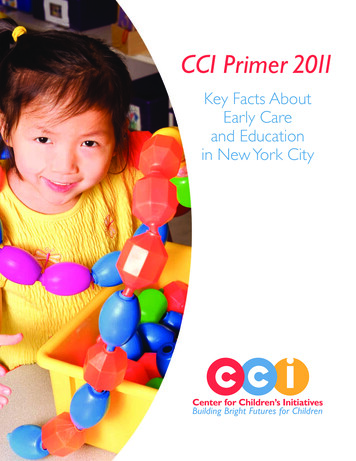
![Josh Smith - Agility [Read-Only]](/img/8/disaster-planning.jpg)
